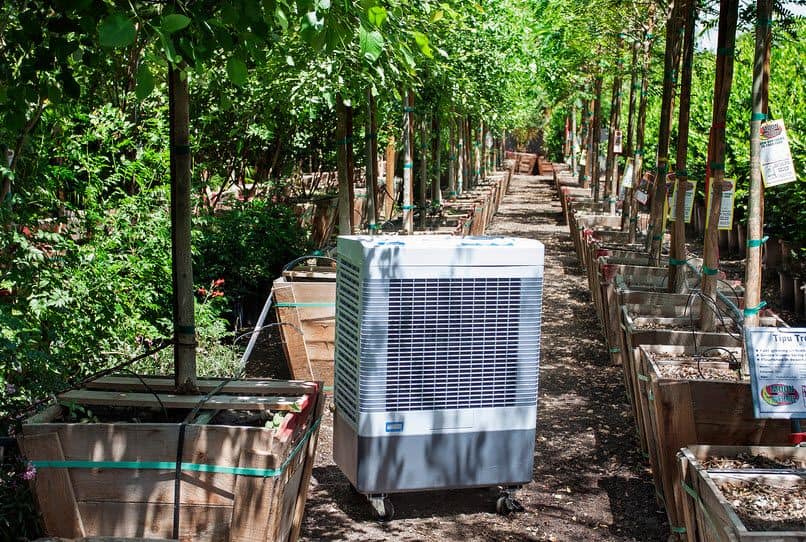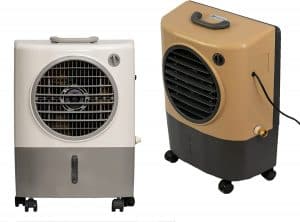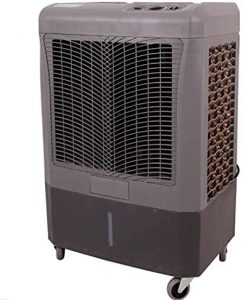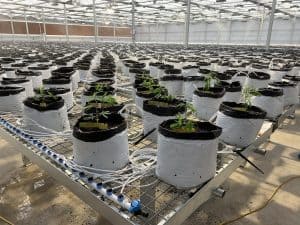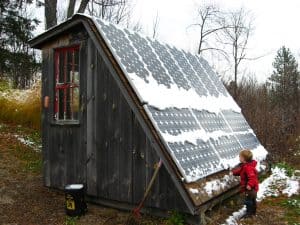There are a plethora of greenhouse cooling systems out there that come at a variety of price points. The best bang for your buck, though, is undoubtedly an evaporative cooler. Evaporative coolers have the potential to cool your greenhouse by over 30-degrees fahrenheit!
But, there are some associated concerns.
How practical are evaporative coolers in greenhouses? Is it an effective hobby greenhouse cooling method? Can you build a DIY evaporative cooler? Is that increase in relative humidity a concern?
In this post we’ll discuss the best greenhouse evaporative coolers along with some other DIY solutions to get your greenhouse temperature back under control.
What to Know About Greenhouse Evaporative Coolers
Greenhouse evaporative coolers work by pushing warm air through moistened cloth pads. The water in the pad absorbs the heat from the air, evaporating and lowering the ambient temperature by as much as 30-degrees! I used one in my air-condition-less apartment in Denver, Colorado where the temperatures in summer were frequently over 100-degrees and was blown away by its effectiveness.
Learn more about the ideal greenhouse temperature to ensure that you make the right decisions regarding cooling.
That being said, evaporative cooling isn’t for everyone. If you live in a particularly humid area, they are less effective at cooling. Furthermore, too much humidity for your plants can result in the growth of mold, bacteria, and root rot. So, we’ve got a greenhouse evaporative cooling calculator to help you decide if its the ideal method of greenhouse cooling for your climate.
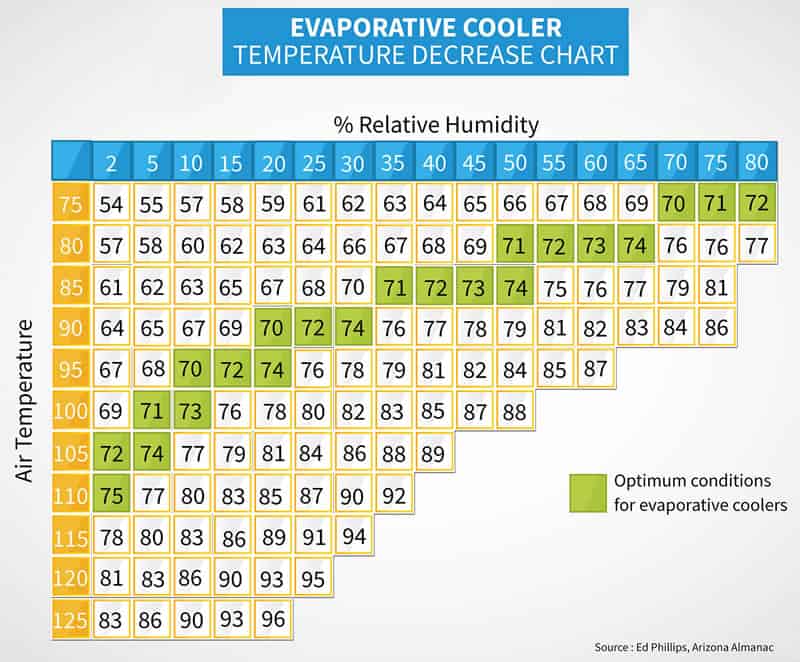
Is a Swamp Cooler the Same as an Evaporative Cooler?
Is an evaporative cooler the same as a swamp cooler? Yes, they are the same thing. That means that you can purchase anything labeled either evaporative or swamp cooler for your greenhouse and get your desired results.
Calculating Evaporative Cooler Requirements
In order to choose a swamp cooler that has the power to effectively cool your greenhouse, you need to know the approximate volume of air in your greenhouse – usually measured in cubic feet.
Since greenhouses are rarely cube-shaped, simply multiplying length x width x height won’t get you a very accurate result. Instead, we approximate the volume with this formula: length x width x (height / 2). That formula assumes you have a more standard gable or A-frame roof and gets you in the right ballpark.
Now you just have to find an evaporative cooler that is rated for that size space. Try some of the suggestions below!
The 3 Best Evaporative Coolers for Greenhouses
| Model | Cubic Feet per Minute (CFM) | Cooling Square Footage | Our Rating | Cost | Check Price | |
|---|---|---|---|---|---|---|
| Hessaire MC18M Portable Evaporative Cooler | 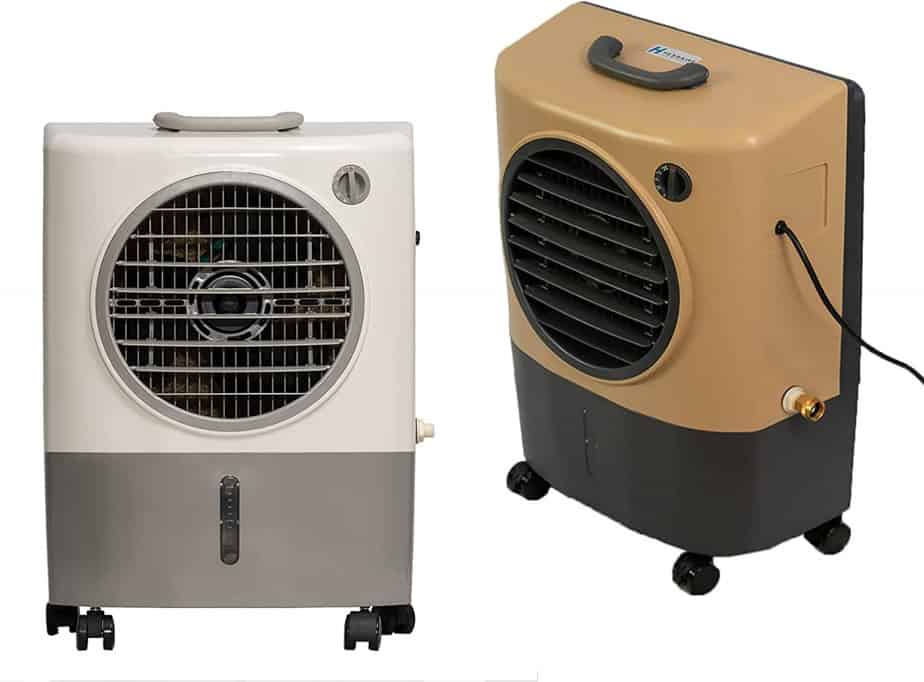 | 1300 CFM | 500 Square Feet | 8.7/10 | $$ | Check Price |
| Hessaire MC37M Portable Evaporative Cooler | 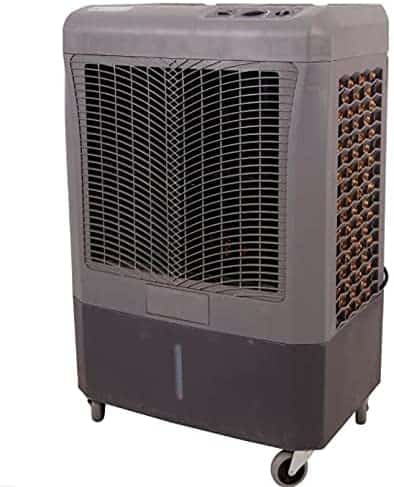 | 3100 CFM | 950 Square Feet | 9.1/10 | $$$ | Check Price |
| Big Ass Fans F-EV1-3601 Cold Front 400 Evaporative Cooler |  | 6,400-9,700 CFM | 3,600 Square Feet | 9.5/10 | $$$$$ | Check Price |
When purchasing an evaporative cooler the two most important things to look for are Cubic Feet Per Minute (CFM) and Square Footage Cooled. The former has to do with the efficiency of the cooler whereas the latter has to do with the area that it is capable of cooling.
For the purposes of this list, I have provided options for a variety of greenhouses sizes so that you’re sure to find one ideal for your particular situation.
Hessaire MC18M Portable Evaporative Cooler
The Hessaire MC18M is the exact model that I used to cool my Denver apartment. If it can cool my scorching kitchen and living room, then it can undoubtedly cool your 4×8 greenhouse without issue. Hessaire provides a 1-year warranty too which makes the MC18M a great option for those in between greenhouse cooling solutions!
This evaporative cooler is also super portable which will allow you to easily transport it around your greenhouse depending on where it is needed most. It may seem obvious but it does become much heavier after filling it with water so move it to your desire location first.
Filling the Hessaire MC18M is efficient too in that you can either attach a garden hose or pour water in via the opening in the side. You may also leave the hose attached and take advantage of the continuous fill feature. The MC18M additionally comes with four different settings so that you can hone in your temperature and humidity to an extent.
Hessaire MC37M Portable Evaporative Cooler
The MC37M from Hessaire features all the affordability and efficiency of the MC18M with around twice the performance! While this one is marginally more expensive, the increases in both CRM and coverage area are anything but. If you have a greenhouse that’s larger than 4×8 but still isn’t industrial sized, then the Hessaire MC37M is probably the best option for you.
At 37″ x 17″ x 24″ the MC37M won’t take up much space in your greenhouse and is fairly portable too. This more advanced evaporative cooler also features more intuitive controls for controlling both the fan and the pump. As is the case with the MC18M, you’ll be able to fill your swamp cooler via the opening in the front or with the hose attachment. The Hessaire MC37M also features continuous fill.
Big Ass Fans F-EV1-3601 Cold Front 400 Evaporative Cooler
This behemoth from Big Ass Fans is an industrial sized greenhouse cooling solution that can condition air as low as 33-degrees! While you certainly would never want your greenhouse to get that cool, if you have a large enough greenhouse then that kind of evaporative cooling power has to be enticing.
The Cold Front 400 features a superior air filter design compared to the competition and is more portable. Again, portability is judged before the water reservoir is filled. To fill the the reservoir you can fill traditionally or utilize the continuous fill feature.
A purchase of the F-EV1-3601 Cold Front 400 is going to run you a pretty penny at just under $3,000 but the peace of mind that you get from that level of control and the manufacturer’s five-year warranty make this a worthwhile purchase for any wholesale greenhouse owner. Remember, you can always get more than one evaporative cooler too!
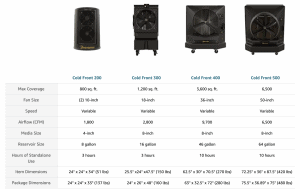
For those readers that aren’t interested in the Hessaire options above and are instead intrigued by this option check out smaller evaporative coolers from Big Ass Fans.
Building a DIY Greenhouse Swamp Cooler
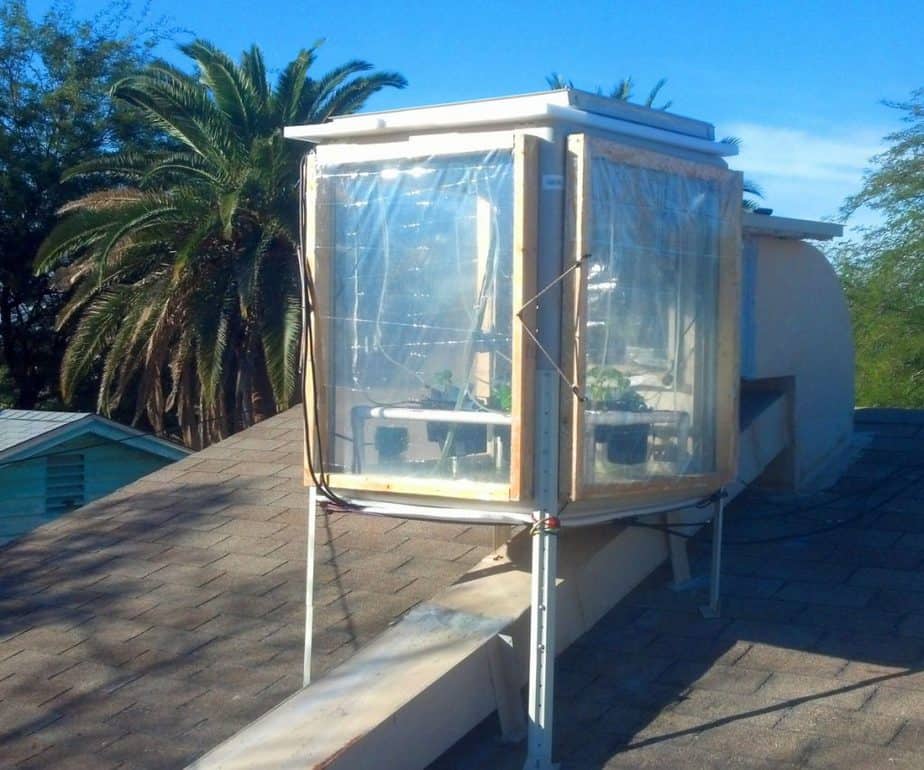
Before we get to the DIY swamp cooler instructions I would be remiss if I didn’t recommend that you also consider a light deprivation method. Light deprivation via shade paint or shade cloth can also decrease the temperature of your greenhouse dramatically without altering humidity levels.
Necessary Materials
Specifics of the materials can be altered based on your needs. If you have any questions or concerns regarding any of these materials then simply comment them and I will respond with clarifications.
- Power drill
- Comes with the all necessary attachments
- Saw
- Nearly any one will work
- 1 1/2″ hole saw drill attachment
- Cooling pads
- 3/4″ PVC pipe with 1/64″ holes every 1″
- Drill 1/64″ holes every 1″
- 360GPH (Gallon per Hour) Water Pump
- 15 gallon tub
- Float valve
- 3/4″ elbows, adapters, and a cap
- 3/4″ tubing (1 x 3′ and 1 x 6′)
- 4″ Vinyl rain gutters
- Silicon sealant
- 1″ bulkhead fitting (1 1/2″ drill attachment to make the necessary hole) and 1″ hose for attaching
- PVC glue
- Screen for bugs
- Staple gun and staples (a hammer and staples works too)
- 6′ piece of 1/2″ hose and hose clamps
- Exhaust fans
DIY Evaporative Cooler Building Steps
Some of these steps can be done out of order and some cannot. Use basic common sense or simply follow the instructions for the best results. These building steps follow those outlined in the video above. So, if you need clarification you can get it there.
- Choose where your evaporative cooler will go
- Cut out or construct a hole in which to build your swamp cooler
- Cut pipes, hoses, and rain gutters to desired lengths
- Cut rain gutter side pieces at a 45-degree angle as they will be the evaporative cooler’s frame
- Attach rain gutter caps for bottom piece of the frame (seal with silicone around the rubber)
- Screw rain gutters into place
- Seal screws with silicone to avoid leaks
- Drill hole for the bulkhead fitting using the 1 1/2″ hole saw attachment (clean the edges)
- Insert bulkhead fitting
- Seal the rubber washer of the bulkhead fitting with silicone
- Add and screw-in the remainder of the rain gutters to finish the frame
- Insert one piece of cooling pad (used to hold the PVC with 1/64″ holes every 1″ in place while we attach it via PVC elbows)
- Ensure that the holes in the PVC pipe point straight down before adding PVC glue into connections
- Add another PVC elbow 90-degree downward
- Insert long piece of PVC with adapter into the PVC elbows (this will connect us to the water pump eventually)
- Finish inserting the cooling pads
- Cut out a notch of the cooling pads for the drain (not necessary but aids in ease of assembly)
- Drill a 3/4″ hole in the middle of the short side of your plastic tub
- Insert and secure float valve
- Seal with silicone
- Attach hose clamps to the outside of the float valve
- Attach hose to hose clamps
- Attach hose to the bulkhead and rest the end of the hose in the plastic tub
- Attach hose from the water pump to the PVC adapter
- Center window screen
- Staple window screen down
- Trim off excess screen
- Plug in the water pump and enjoy the relief of cool air!
Is a Swamp Cooler the Best Way to Cool a Greenhouse?

You’re now ready to install or build evaporative coolers in greenhouses. You should understand:
- what is an evaporative cooler?
- how can an evaporative cooler help my greenhouse temperature?
- what are the best greenhouse evaporative coolers?
- how to build a DIY swamp cooler for your greenhouse
If you find that the humidity levels in your greenhouse are out of wack then it may be worth looking into a dehumidifier or a humidifier based on which side of the spectrum your grow house is on.
Are you going to purchase one of the options from this list or build your own DIY greenhouse swamp cooler? Comment which is the best option for you and discuss with other fellow greenhouse enthusiasts what has and hasn’t worked for you in the past. Together we can get our greenhouse temperatures under control!

